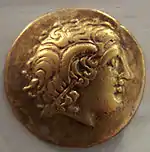Seduni
The Seduni were a Gallic tribe dwelling in the upper Rhône valley, around modern Sion, Switzerland, during the Iron Age and the Roman period.
Along with the Nantuates, Veragri and Uberi, they were part of the Vallenses, a group of tribes living between the Lake Geneva and the Pennine Alps, in the modern canton of Valais (Switzerland).[1]
Name
They are mentioned as Sedunos, Sedunorum and Sedunis by Caesar (mid-1st c. BC),[2] and as Seduni by Livy (late 1st c. BC) and Pliny (1st c. AD).[3][4]
The meaning of the ethnonym Seduni remains unclear. According to Alexander Falileyev, it may be based on the Celtic root *sedo-, meaning 'tumulus (inhabited by supernatural beings)' and 'peace'.[4] Pierre-Yves Lambert has also proposed to analyze the name as a haplology (loss of syllabe) for *Sego-dunum ('the strong fortress').[5]
Geography
The Seduni dwelled in the upper Rhône valley, in the modern canton of Valais.[6] Their territory was located east of the Nantuates and Veragri, south of the Uberi, and west of the Lepontii.[7] After the Roman conquest in 16–15 BC, their territory was initially administered in common with Raetia et Vindelicia under a legatus, then integrated into the Alpes Graiae et Poeninae by Claudius (41–54 AD).[1]
In Late Antiquity, their chief town was known as Sedunum (modern Sion, Switzerland), which was named after them.[6]
History
They fought against the Roman forces of Caesar at the Battle of Octodurus (in modern-day Martigny, Switzerland).
The territory of the Vallenses was occupied by the Roman forces of Augustus after the Alpine campaign of 16–15 BC.[1] The Seduni are mentioned in the Trophy of the Alps.[8]
References
- Graßl 2006b.
- Caesar. Commentarii de Bello Gallico, 3:1:, 3:2:, 3:7.
- Livy. Ab Urbe Condita Libri, 21:38:9; Pliny. Naturalis Historia, 3:137.
- Falileyev 2010, s.v. Seduni and Sedunum.
- Lambert 1994, p. 34.
- Graßl 2006a.
- Talbert 2000, Map 18: Augustonemetum-Vindonissa.
- Pliny. Naturalis Historia, 3:137.
Primary sources
- Caesar (1917). The Gallic War. Loeb Classical Library. Translated by Edwards, H. J. Harvard University Press. ISBN 978-0-674-99080-7.
- Livy (2019). History of Rome. Loeb Classical Library. Translated by Yardley, J. C. Harvard University Press. ISBN 978-0674992566.
- Pliny (1938). Natural History. Loeb Classical Library. Translated by Rackham, H. Harvard University Press. ISBN 9780674993648.
Bibliography
- Falileyev, Alexander (2010). Dictionary of Continental Celtic Place-names: A Celtic Companion to the Barrington Atlas of the Greek and Roman World. CMCS. ISBN 978-0955718236.
- Graßl, Herbert (2006a). "Seduni". Brill’s New Pauly. doi:10.1163/1574-9347_bnp_e1106370.
- Graßl, Herbert (2006b). "Vallenses". Brill’s New Pauly. doi:10.1163/1574-9347_bnp_e1228280.
- Lambert, Pierre-Yves (1994). La langue gauloise: description linguistique, commentaire d'inscriptions choisies. Errance. ISBN 978-2-87772-089-2.
- Talbert, Richard J. A. (2000). Barrington Atlas of the Greek and Roman World. Princeton University Press. ISBN 978-0691031699.
